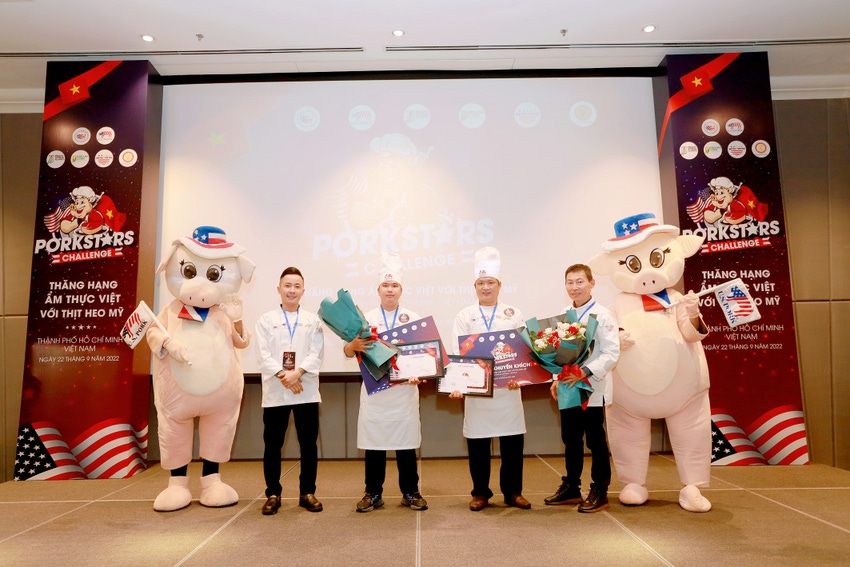Nationwide chef competition increases awareness, differentiates U.S. pork as top quality.
November 9, 2022

The U.S. pork industry has long had its eye on Vietnam and with the Vietnamese economy picking up steam, efforts to develop the market for high-quality U.S. pork are advancing.
Vietnam is bucking Asia's weakening growth trend, according to the International Monetary Fund. In September, IMF raised Vietnam's economic forecast by one full percentage point – to 7% – for 2022.
Economic growth was among many factors in Pork Checkoff-funded research conducted in 2020 that identified Vietnam as an emerging market for U.S. pork. The research also noted Vietnam's young and growing population and pork's standing as consumers'Â favorite animal protein with annual per capita consumption near 60 pounds.
Recent forecasts from the Organization for Economic Cooperation and Development state that from 2022 to 2030, pork consumption in Vietnam will grow 3.1% per year to around 3.4 million metric tons. Consumption of chilled meat is increasing sharply thanks to convenience and quality factors.
"Pork is already the preferred meat in Vietnam and as incomes rise, demand will grow for high-quality pork,"Â says Le Van Anh Tu, Vietnam representative of U.S. Meat Export Federation. "But we definitely have work ahead of us, as Vietnam is a price-sensitive market and consumers typically think of imported pork as lower-quality. So we are working to differentiate U.S. pork through chefs and other influencers on social media."
Producer groups support cooking competition
One such effort took place recently in Ho Chi Minh City, as 30 leading chefs from across Vietnam competed to be the country's top "pork star."Â The PorkStars Challenge cooking competition, made possible through funding from the Indiana Soybean Alliance, Indiana Corn Marketing Council and the National Pork Board, was designed to showcase U.S. pork as the center-of-the-plate choice for innovative chefs and social media influencers.
Emerging markets such as Vietnam are very important to the pork industry, and therefore to Indiana corn and soybean producers, says Courtney Kingery, CEO of Indiana Soybean Alliance and Indiana Corn Marketing Council.
"We had heard from our USMEF partners that the Vietnam marketplace is primed for long-term growth,"Â Kingery explains. "There are more people working, and more women working, in this incredibly young country. By the time they get off work, they don't have time to go to the wet markets to get their meat. So you see more consumers buying pork in what we would consider more traditional Western markets."
The PorkStars Challenge started with 100 contestants from all regions of Vietnam who competed to be one of the 30 finalists brought to the main event in Ho Chi Minh City. Each of the 30 chefs prepared two dishes for the three judges, each one a premier Vietnamese chef. The winning entry utilized U.S. pork with native tropical fruit and spice from northwestern Vietnam.

Competition finalists generated 60 recipes that will be further promoted by USMEF in traditional and social media for use in Vietnam's foodservice sector and for at-home cooking.
"Indiana producers were happy to represent the industry at this event to help tell the story about how high-quality feed inputs contribute to an exceptional product that meets the needs of consumers in Vietnam,"Â says Kingery. A video of the competition can be seen here:
U.S. pork faces tariff disadvantages in Vietnam
While market potential is promising in Vietnam, U.S. pork faces stiff competition from pork suppliers who benefit from lower tariffs.
Imports helped fill the void caused by the devastation of Vietnam's pork production capacity by African swine fever, which began in 2019. Despite government plans to foster large-scale pork operations, production in Vietnam is still characterized by small-scale producers and is dependent on high-priced, imported feed inputs.
U.S. market share has declined since 2020. Although Vietnam reduced the tariff on U.S. pork from 15% to 10% in July through a reduction in the Most Favored Nation tariff rate, competitors still receive lower tariffs.
Russia is a leading supplier of pork into Vietnam, with Russian product entering the market at zero duty thanks to an agreement with the Eurasian Economic Union. Russia's market access to other countries is severely limited by ASF, so Russian exports are heavily reliant on Vietnam.
Vietnam's tariff on Canadian pork is currently 5.6%, as rates continue to phase to zero under the Comprehensive and Progressive Agreement for Trans-Pacific Partnership. Canada's exports to Vietnam surged following implementation of CPTPP.
The European Union is the top supplier of pork to Vietnam, with its duty at 9.4% under the EU-Vietnam Free Trade Agreement. Germany, which faces limited access elsewhere due to ASF, is a top EU supplier to Vietnam.
As work continues with pork industry groups and government agencies to further reduce tariffs for U.S. pork in Vietnam, market development efforts will continue in foodservice and in Vietnam's rapidly evolving retail and processing sectors.
"Vietnam has great potential for our pork if we can get on a level playing field,"Â says Mark Legan, a hog farmer from Coatesville, Indiana, who represents Indiana Soybean Alliance and serves on the USMEF Executive Committee. "Consumer demand for convenience-oriented products will drive changes in this market and if we can achieve tariff equivalency, U.S. pork will be well-positioned to meet Vietnam's growing demand for high-quality protein."
Source: U.S. Meat Export Federation, which is solely responsible for the information provided, and wholly owns the information. Informa Business Media and all its subsidiaries are not responsible for any of the content contained in this information asset.Â
About the Author(s)
You May Also Like



